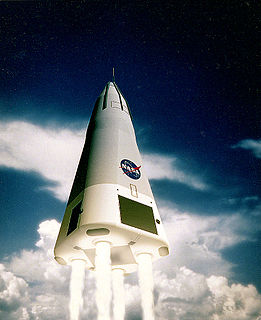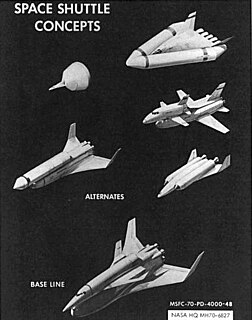
The Agena Target Vehicle (ATV), also known as Gemini-Agena Target Vehicle (GATV) was an uncrewed spacecraft used by NASA during its Gemini program to develop and practice orbital space rendezvous and docking techniques, and to perform large orbital changes, in preparation for the Apollo program lunar missions. The spacecraft was based on Lockheed Aircraft's Agena-D upper stage rocket, fitted with a docking target manufactured by McDonnell Aircraft. The name 'Agena' derived from the star Beta Centauri, also known as Agena. The combined spacecraft was a 26-foot (7.92 m)-long cylinder with a diameter of 5 feet (1.52 m), placed into low Earth orbit with the Atlas-Agena launch vehicle. It carried approximately 14,021 to 14,054 pounds of propellant and gas at launch, and had a gross mass at orbital insertion of 7,117 to 7,271 pounds.

Delta is an American versatile family of expendable launch systems that has provided space launch capability in the United States since 1960. More than 300 Delta rockets have been launched with a 95% success rate. Only the Delta IV Heavy rocket remains in use as of November 2020. Delta rockets are currently manufactured and launched by the United Launch Alliance.

The Lockheed Martin X-33 was an uncrewed, sub-scale technology demonstrator suborbital spaceplane developed in the 1990s under the U.S. government–funded Space Launch Initiative program. The X-33 was a technology demonstrator for the VentureStar orbital spaceplane, which was planned to be a next-generation, commercially operated reusable launch vehicle. The X-33 would flight-test a range of technologies that NASA believed it needed for single-stage-to-orbit reusable launch vehicles, such as metallic thermal protection systems, composite cryogenic fuel tanks for liquid hydrogen, the aerospike engine, autonomous (uncrewed) flight control, rapid flight turn-around times through streamlined operations, and its lifting body aerodynamics.

The McDonnell DouglasX-36Tailless Fighter Agility Research Aircraft was an American stealthy subscale prototype jet designed to fly without the traditional tail assembly found on most aircraft. This configuration was designed to reduce weight, drag and radar cross section, and increase range, maneuverability and survivability.

The DC-X, short for Delta Clipper or Delta Clipper Experimental, was an uncrewed prototype of a reusable single-stage-to-orbit launch vehicle built by McDonnell Douglas in conjunction with the United States Department of Defense's Strategic Defense Initiative Organization (SDIO) from 1991 to 1993. Starting 1994 until 1995, testing continued through funding of the US civil space agency NASA. In 1996, the DC-X technology was completely transferred to NASA, which upgraded the design for improved performance to create the DC-XA.

Big Gemini was proposed to NASA by McDonnell Douglas in August 1969 as an advanced version of the Gemini spacecraft system. It was intended to provide large-capacity, all-purpose access to space, including missions that ultimately used Apollo or the Space Shuttle.

Project Gemini was NASA's second human spaceflight program. Conducted between projects Mercury and Apollo, Gemini started in 1961 and concluded in 1966. The Gemini spacecraft carried a two-astronaut crew. Ten Gemini crews and sixteen individual astronauts flew low Earth orbit (LEO) missions during 1965 and 1966.

The Boeing Bird of Prey was a black project aircraft, intended to demonstrate stealth technology. It was developed by McDonnell Douglas and Boeing in the 1990s. The company provided $67 million of funding for the project; it was a low-cost program compared to many other programs of similar scale. It developed technology and materials which would later be used on Boeing's X-45 unmanned combat air vehicle. As an internal project, this aircraft was not given an X-plane designation. There are no public plans to make this a production aircraft. It is characterized as a technology demonstrator.

The Rockwell X-30 was an advanced technology demonstrator project for the National Aero-Space Plane (NASP), part of a United States project to create a single-stage-to-orbit (SSTO) spacecraft and passenger spaceliner. Started in 1986, it was cancelled in the early 1990s before a prototype was completed, although much development work in advanced materials and aerospace design was completed. While a goal of a future NASP was a passenger liner capable of two-hour flights from Washington to Tokyo, the X-30 was planned for a crew of two and oriented towards testing.

Philip Bono was a Douglas Aircraft Company engineer. He was a pioneer of reusable vertical landing single-stage to orbit launch vehicles. As a visionary designer, he is credited with inventing the first version of a recoverable single-stage spacecraft booster, and his contributions influenced spacecraft design.

Before the Project Apollo Moon landing in 1969, NASA began studies of Space Shuttle designs as early as October 1968. The early studies were denoted "Phase A", and in June 1970, "Phase B", which were more detailed and specific. The primary intended use of the Space Shuttle was supporting the future space station, ferrying a minimum crew of four and about 20,000 pounds (9,100 kg) of cargo, and able to be rapidly turned around for future flights.

The McDonnell Douglas F-15 STOL/MTD is a modified F-15 Eagle. Developed as a technology demonstrator, the F-15 STOL/MTD carried out research for studying the effects of thrust vectoring and enhanced maneuverability. The aircraft used for the project was pre-production TF-15A (F-15B) No. 1, the first two-seat F-15 Eagle built by McDonnell Douglas, the sixth F-15 off the assembly line, and was the oldest F-15 flying up to its retirement. It was also used as the avionics testbed for the F-15E Strike Eagle program. The plane was on loan to NASA from the United States Air Force.

The McDonnell 119/220 is a business jet developed and unsuccessfully marketed by McDonnell Aircraft in the late 1950s and early 1960s. Its configuration is unique for this type of aircraft, with four podded engines underneath a low wing. It is the only airplane built by McDonnell to be marketed to civil buyers prior to the company's merger with Douglas Aircraft to form McDonnell Douglas. The jet could be outfitted for 10 passengers in a luxury executive configuration and could carry as many as 29.

The Pelikan tail is an experimental tail design for fighter jets. It was originally conceived by Ralph Pelikan, who was hired by McDonnell Aircraft, later worked for McDonnell Douglas after the merger of McDonnell with Douglas and, after another merger, retired from Boeing. His design has not to date been incorporated into any publicly available aircraft. However, it has been considered or included in design specifications in the original Boeing X-32 fighter design.
The Thor-Burner was an American expendable launch system, a member of the Thor rocket family. It consisted of a Thor missile, with one or two Burner upper stages. It was used between 1965 and 1976 to orbit a number of satellites, most commonly Defense Meteorological Satellite Program weather satellites. Twenty-four were launched, of which two failed. It weighed 51,810 kg and was 24 metres tall.

The Delta IV Heavy is an expendable heavy-lift launch vehicle, the largest type of the Delta IV family and the world's second highest-capacity rocket in operation, behind SpaceX's Falcon Heavy rocket. It is manufactured by United Launch Alliance and was first launched in 2004.

The Delta 3000 series was an American expendable launch system which was used to conduct 38 orbital launches between 1975 and 1989. It was a member of the Delta family of rockets. Several variants existed, which were differentiated by a four digit numerical code.
The Zarya spacecraft was a secret Soviet project of the late 1980s aiming to design and build a large crewed vertical-takeoff, vertical-landing (VTVL) reusable space capsule, a much larger replacement for the Soyuz (spacecraft). The project was developed during 1985 - 1989 years by Energia corporation until it was shelved in 1989, "on the eve of the Soviet Union's collapse" due to lack of funding. The name of the project was later reused by the Zarya space station module which served as the first component of International Space Station in 1998.
Lockheed's Star Clipper was a proposed Earth-to-orbit spaceplane based on a large lifting body spacecraft and a wrap-around drop tank. Originally proposed during a USAF program in 1966, the basic Star Clipper concept lived on during the early years of the NASA Space Shuttle program, and as that project evolved, in a variety of new versions like the LS-200.
Douglas Aircraft's SASSTO, short for "Saturn Application Single Stage to Orbit", was a single-stage-to-orbit (SSTO) reusable launch system designed by Philip Bono's team in 1967. SASSTO was a study in minimalist designs, a launcher with the specific intent of repeatedly placing a Gemini capsule in orbit for the lowest possible cost. The SASSTO booster was based on the layout of the S-IVB upper stage from the Saturn family, modified with a plug nozzle. Although the SASSTO design was never followed up at Douglas, it is widely referred to in newer studies for SSTO launchers, notably the MBB "Beta" design, which was largely an updated version of SASSTO.















